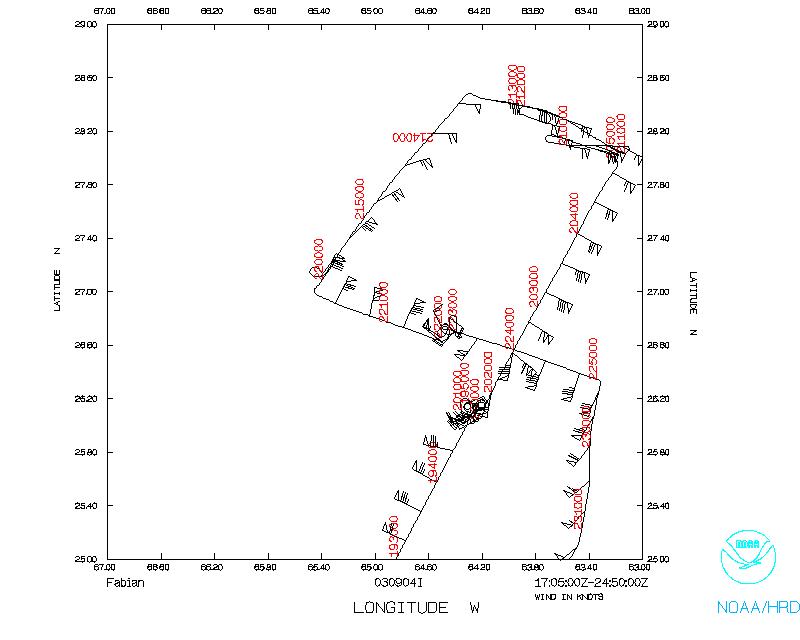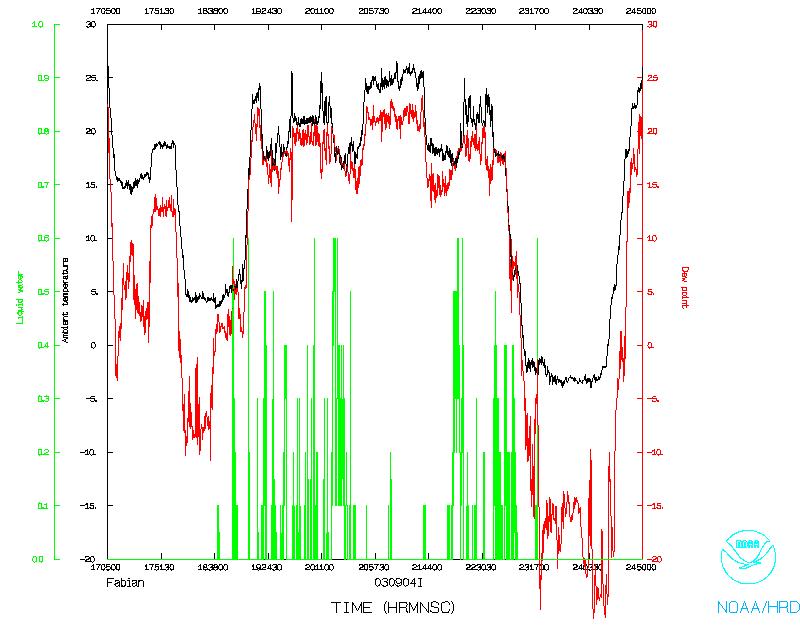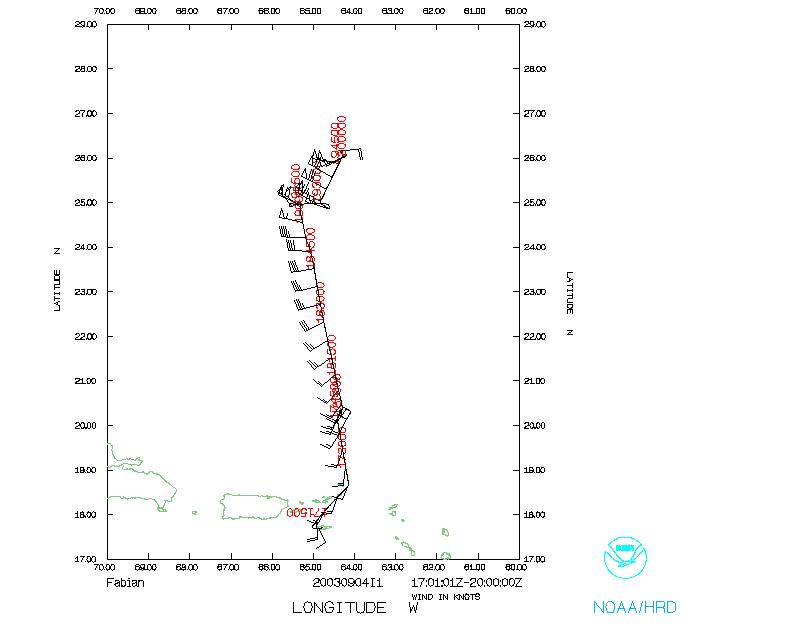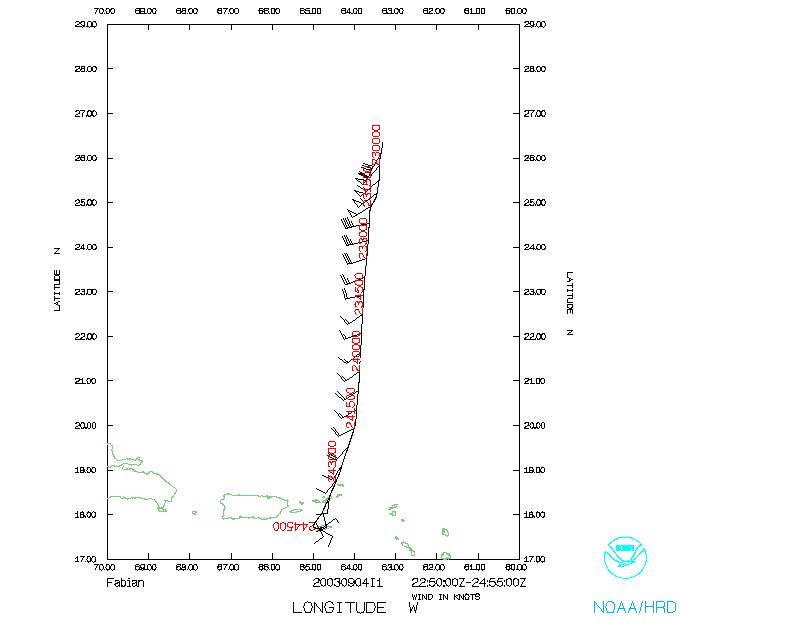Flight Data | ||
 Flight track |
 Temperature and Moisture |
 Wind and Altitude |
 Flight track start |
 Flight track end |
|
| Lead Scientist | Chris Landsea |
| Radar Scientist | Rob Rogers |
| Sonde Scientist | Mike Black |
| AXBT Scientist | Eric Uhlhorn |
| CBLAST Scientist | Jeff French |
| CBLAST Scientist | Jim Laswell |
| C-Scat Scientist | Ed Walsh |
Mission Plan :
This mission, in conjunction with NRF42, was a CBLAST experiment to measure turbulent flux conditions in relatively high winds near the ocean-atmosphere boundary. The flight plans for this day were to first conduct stair-stepped descents on 43, followed by a figure four by both planes launching a 12 sonde sequence (8 from 42 straddling the flight level RMW and 4 from 43 straddling the surface RMW). We also had the opportunity to attempt to do the east-west portion of the figure four over the location that numerous floats/buoys were deployed the day before.
Mission Summary :
The plane left St.Croix at 1:00 PM AST (1700 UTC). We first conducted the box and circle calibration manuevers for the BAT probe (1740 to 1800 UTC). Right after that Jeff French announced that the BAT probe was having problems measuring winds. (It turned out later that Jeff was able to get considerable good data from the BAT probe.) At 1900 UTC, we attempted to find a place in the SW quadrant of Fabian to do the stepped descent, but decided to postpone this portion until later in the flight when a good rainfree region could be found. We proceeded with the coordinated figure four, going through the SW eyewall and launching our four sondes and two AXBTs, circling in the eye to allow AVAPS to prepare to launch another round of sondes, then proceeding through the NE eyewall and again launching our four sondes and two AXBTs. The radar depicted a concentric eyewall structure with two peaks in winds at flight level (80 kt outer/90 kt inner) and a single peak at the SFMR (80 kt) on the SW side. Peak flight level winds were about 130 kt on the NE side with a large area of at least 120 kt, though there was some problem with the SFMR on this side of the storm (interference with the AXBT signal?).
At this point (2045 UTC), we found a candidate region for the stepped descent in the NE side (front quadrant) of the hurricane. The stepped descent was done in coordination with 43 and included the following legs:
| Leg | Track | Alt (ft) | Start time (UTC) | End time (UTC) Upwind | 105° | 1200 | 20:58:00 | 21:05:09
| Downwind | 300° | 900 | 21:12:44 | 21:16:20
| Upwind | 110° | 600 | 21:22:07 | 21:25:15
| Downwind | 280° | 400 | 21:28:53 | 21:32:52
| Inward | 220° | 400 | 21:37:30 | 21:38:55
| |
As can be seen from the stepped leg summary and the figure, it was difficult to fly for the requested 20 nmi legs over the same region. This was because of moving and developing rainbands in this portion of the storm. In general, the legs were done over surface winds around 35-45 kt, with a couple spots to 50 kt. A leg down to 200 feet was not possible nor were cross wind legs possible because of the limited clear area to work with in the hurricane.
After completion of the stepped descent sequence (2200 UTC), we resumed the figure four flight pattern. This pass through began on the NW side of Fabian, four GPS drops in the NW eyewall, circle in the eye as AVAPS prepared for more drops, and then fly outbound through the SE eyeall again dropping four dropsondes. There was again concentric eyewall pattern with double peaked flight level winds (110 kt each on NW side and 115 kt [inner]/105 kt [outer] on the SE side), while the SFMR had peak winds of about 80 kt in the outer eyewall and 90 kt on the inner eyewall. Throughout the flight, the surface RMW was just slightly inward of the flight level wind maximum. We returned to St.Croix at 9:00 PM AST.
Overall the flight went as hoped, despite the in-flight changes made to the mission plan. The instrumentation (SFMR, BAT probe, GPS sondes and AXBTs) worked quite well in general, with 9 out of the 16 GPS sondes providing winds below 30 m (3 of which had near surface winds greater than 100 kt). Portions of the flight - especially the legs of the figure four pattern - crossed over the deployed floats/buoys.
Problems :
Once again it was very difficult to fit in the stepped descent part of the pattern with rain all over the place. The BAT probe again had problems with ingesting too much water. However, a rain free area was finally located in a region of 45 kt winds in the front quadrant of the storm, which will be an excellent complement to the one flown on Tuesday in the rear of the storm- the former being in wave conditions where swell was running at right angle to the wind in local seas that were high, but not too steep. This is in contrast to the rear quadrant conditions where short, steep waves were observed.
Chris Landsea LPS
Mission Data :
Flight Data | ||
 Flight track |
 Temperature and Moisture |
 Wind and Altitude |
 Flight track start |
 Flight track end |
|
Future Plans :
I spent almost 3 hours in a debrief with the WC-130J crew, who were ecstatic upon hearing that the buoys worked. The 53rd crew exemplified the same spirit of enthusiasm, professionalism and attention to detail that AOC's two P-3 crews have demonstrated, that HRD and CBLAST Pi's have demonstrated- something that has characterized every single group participating in this experiment- and is the prime reason for its success.
Peter G. Black
HRD Field Program Director
Return to Mission page.